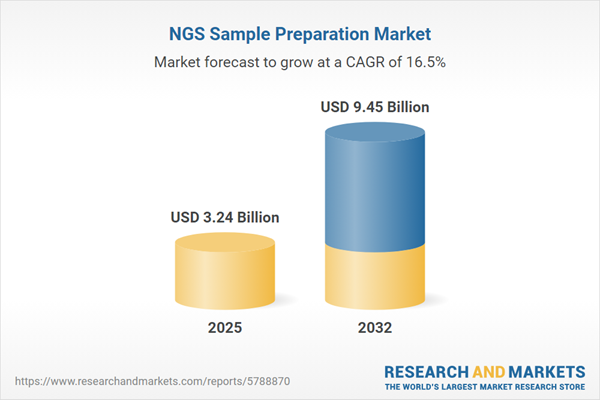Speak directly to the analyst to clarify any post sales queries you may have.
The NGS sample preparation market is rapidly transforming operational standards for healthcare and research organizations worldwide. As innovation and regulatory requirements accelerate, senior decision-makers must adopt agile strategies to maintain quality, resilience, and competitive advantage within this dynamic segment.
Market Snapshot: NGS Sample Preparation Market Trends and Outlook
The next generation sequencing (NGS) sample preparation market continues to gain momentum, propelled by the rising adoption of genomics across healthcare and life science sectors. Demand is driven by advances in precision medicine and a broadening of research objectives, resulting in a need for efficient, reliable workflow solutions. The shift toward automated and scalable sample preparation reflects organizations’ priorities for operational efficiency and consistency. Strategic partnerships, collaborative research, and regulatory attentiveness shape market performance, with innovation seen as a critical component for sustaining leadership. As this sector evolves, aligning emerging solutions with up-to-date compliance frameworks and scientific best practices becomes increasingly essential for long-term success.
Scope & Segmentation: NGS Sample Preparation Market Coverage
- Product Type: Amplification kits are central to both traditional and digital PCR workflows. Rolling circle amplification leverages unique probes and specialized polymerases for advanced research. Mechanical and enzymatic fragmentation tools accommodate varied laboratory needs, while library preparation kits are commonly chosen for specific applications such as oncology or RNA sequencing. Enrichment kits facilitate streamlined sample processing, including hybrid capture and amplicon-based approaches.
- Application: NGS sample preparation supports diverse applications. Techniques enable epigenetic research like bisulfite conversion and ChIP sequencing, as well as metagenomics using rRNA and shotgun sequencing. Advanced RNA profiling with mRNA and miRNA assays underpins both exploratory and applied research focused on oncology, rare diseases, and pharmacogenomics.
- Technology: Bead-based and enzyme-driven systems remain widely used across the industry. Ligases, restriction enzymes, and transposases are integral components, while microfluidic and droplet-based high-throughput platforms are being adopted for faster, more precise sample handling. Modern PCR platforms provide optimized workflow speed and reliability.
- Workflow Step: The workflow spans amplification, enrichment, fragmentation, and library construction. At each stage, rigorous quality control is maintained with electrophoretic and fluorometric checks to ensure data consistency and reliability in sequencing outputs.
- End User: Leading end users include academic institutions, health agencies, contract research organizations, clinical laboratories, and pharmaceutical and biotechnology firms. These stakeholders depend on advanced NGS preparation to achieve operational consistency and fulfill regulatory demands.
- Regional Analysis: The Americas, Europe, Middle East and Africa, and Asia-Pacific all drive market expansion. Diverse regulatory climates, particularly in China, India, Japan, and Australia, shape local product adoption and compliance strategies. Senior leaders should evaluate region-specific requirements and supply chain conditions to tailor successful market entry and expansion plans.
- Company Landscape: Key industry players include Illumina, Thermo Fisher Scientific, QIAGEN, Roche Diagnostics, and Agilent Technologies. Regional companies are adopting collaborative models and expanding technical capabilities, boosting their competitiveness within fast-evolving market segments.
Key Takeaways for Senior Leaders
- Investing in microfluidic and digital PCR technologies can raise laboratory throughput and increase the accuracy of both standard and complex sequencing workflows.
- Implementing automation minimizes sample preparation variability, supporting uniform performance and facilitating seamless scalability across laboratory networks.
- Ongoing regulatory changes call for continuous strengthening of quality control and compliance throughout all NGS sample preparation steps to maintain industry standards.
- Collaboration with suppliers and research institutions propels technology development and expedites the market readiness of new solutions.
- Utilizing segment-driven strategies helps align operational priorities with evolving technology needs, enabling organizations to target new areas of genomics research effectively.
- Employing diversified sourcing and supply chain strategies strengthens resilience and limits exposure to external disruptions and international sourcing risks.
Tariff Impact: Navigating 2025 U.S. Trade Developments
Forthcoming tariffs affecting NGS sample preparation imports—including enzymes, plastics, and oligonucleotides—will require decisive action from senior management. Assessing alternative sourcing, optimizing procurement frameworks, and enhancing supply chain planning will help organizations maintain operational continuity and flexibility amid changing trade conditions.
Methodology & Data Sources
This report integrates feedback from major reagent manufacturers, sequencing technology providers, and clinical diagnostics entities. It synthesizes insights from scientific literature, regulatory filings, and company disclosures to provide a comprehensive, up-to-date perspective on market developments and technology trends.
Why This Report Matters
- Empowers senior leaders to make data-driven decisions on procurement, workforce planning, and technology investments in the evolving NGS sample preparation market.
- Delivers relevant, actionable analysis of new technical solutions, regulatory pressures, and global trade shifts, supporting strategic positioning and sustained competitiveness.
- Highlights localized market perspectives and growth opportunities in regulated settings, enabling more targeted and effective business development initiatives.
Conclusion
This report offers decision-makers clear, actionable insights for navigating the NGS sample preparation market. By understanding evolving market dynamics, leaders can enhance operational stability and propel advances in genomics-driven healthcare and research.
Additional Product Information:
- Purchase of this report includes 1 year online access with quarterly updates.
- This report can be updated on request. Please contact our Customer Experience team using the Ask a Question widget on our website.
Table of Contents
3. Executive Summary
4. Market Overview
7. Cumulative Impact of Artificial Intelligence 2025
Companies Mentioned
The companies profiled in this NGS Sample Preparation market report include:- Illumina, Inc.
- Thermo Fisher Scientific Inc.
- QIAGEN N.V.
- Roche Diagnostics International Ltd.
- Agilent Technologies, Inc.
- New England Biolabs, Inc.
- Takara Bio Inc.
- PerkinElmer, Inc.
- Bio-Rad Laboratories, Inc.
- Promega Corporation
- Merck KGaA
- BGI Genomics Co., Ltd.
- Promega Corporation
- Sysmex Corporation
- Novogene Co., Ltd.
Table Information
| Report Attribute | Details |
|---|---|
| No. of Pages | 183 |
| Published | October 2025 |
| Forecast Period | 2025 - 2032 |
| Estimated Market Value ( USD | $ 3.24 Billion |
| Forecasted Market Value ( USD | $ 9.45 Billion |
| Compound Annual Growth Rate | 16.5% |
| Regions Covered | Global |
| No. of Companies Mentioned | 16 |









